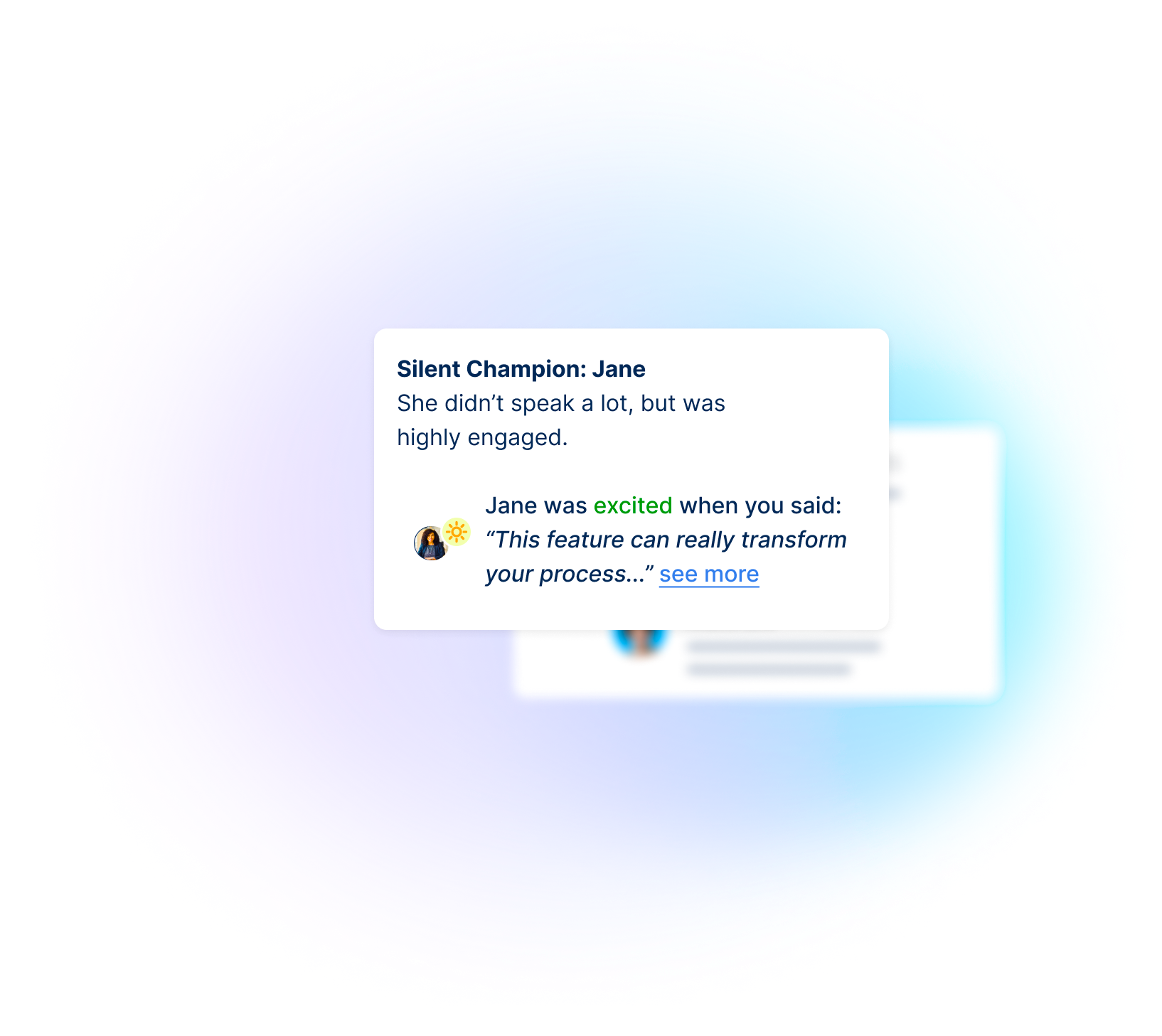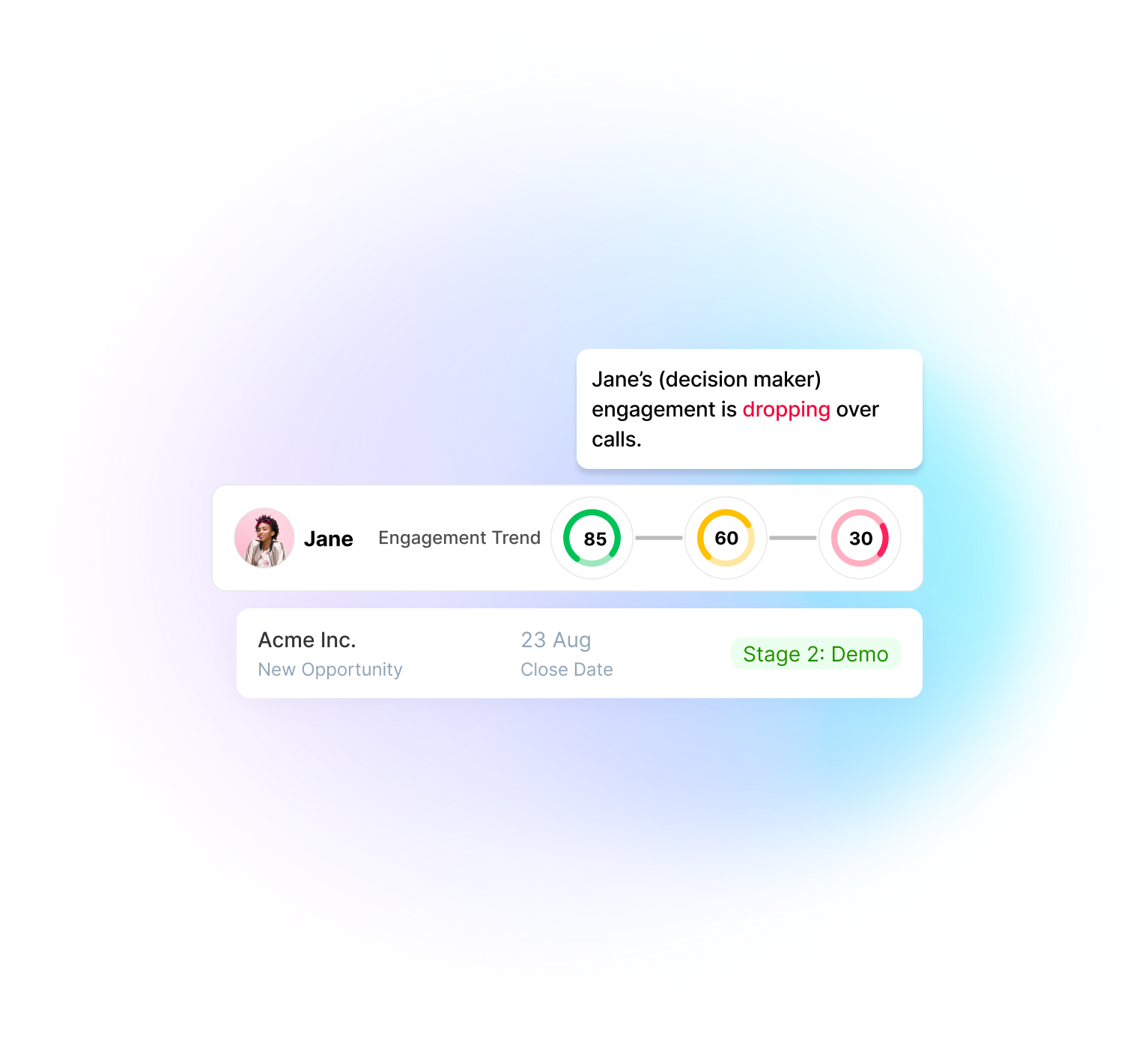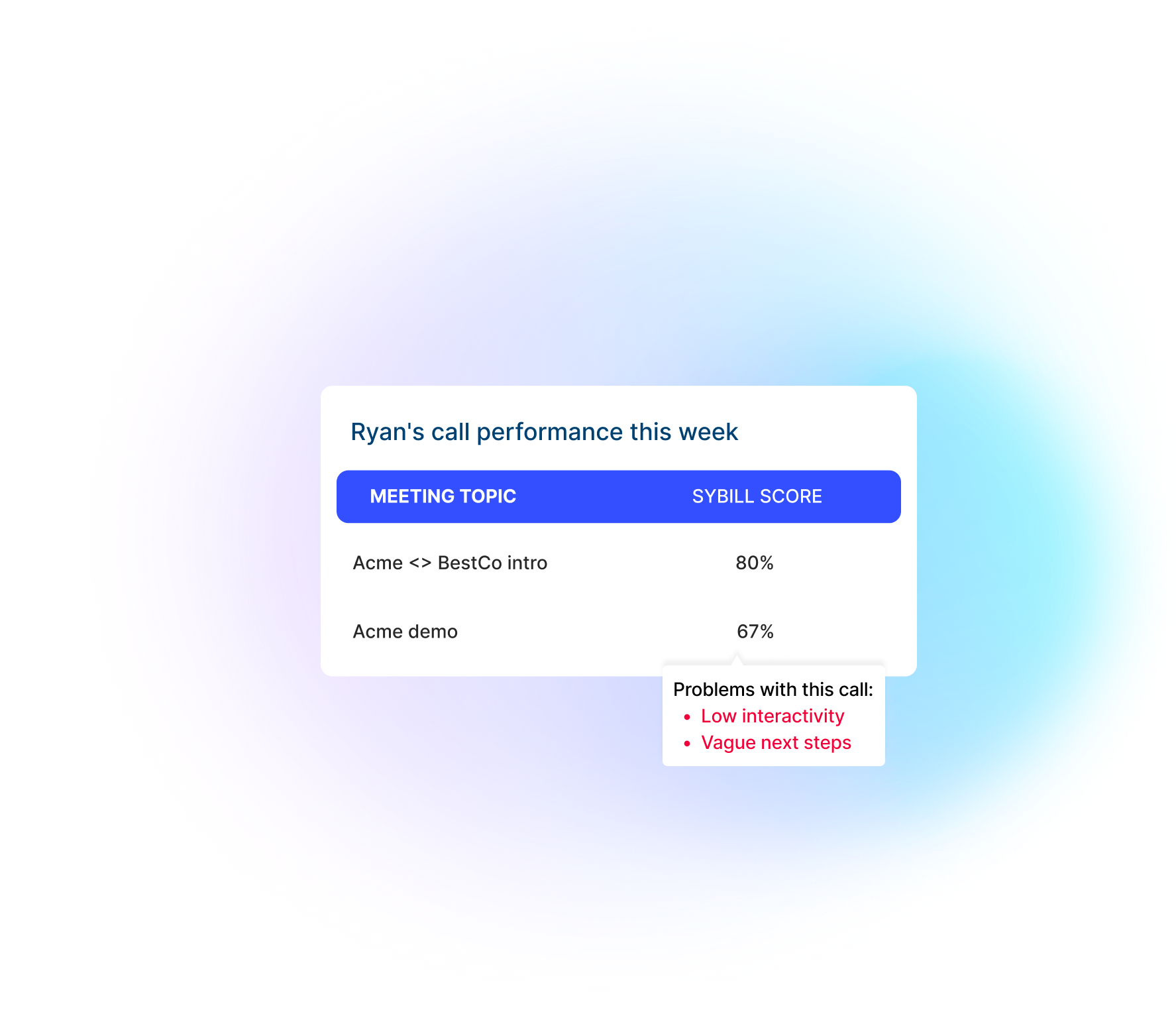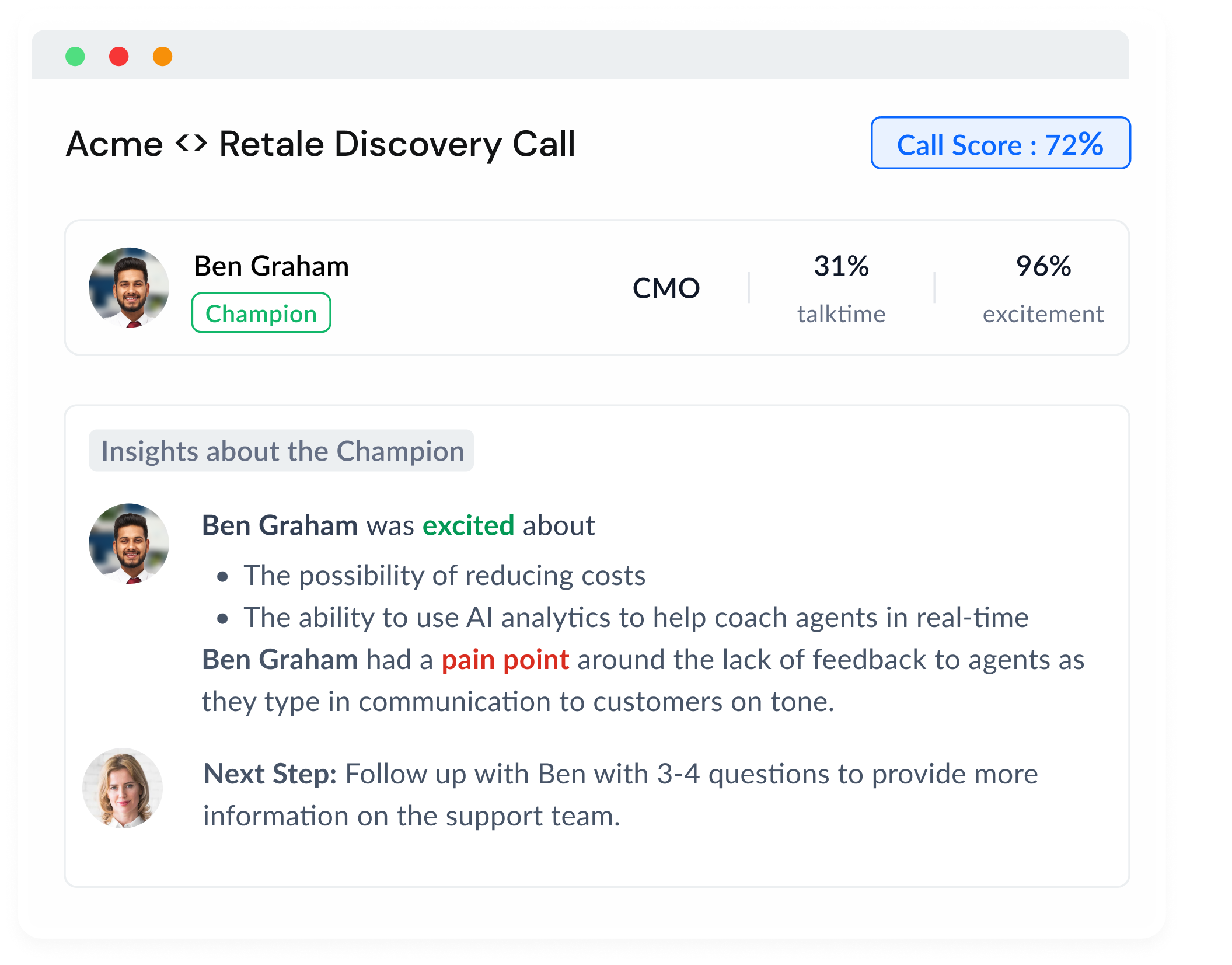I get off a video sales call with John, Mary, Douglas, and Tina from Acme Inc.
A few minutes after the call, I get an alert on our company Slack that the call went well. The Slack alert also mentions that there are 3 next steps that I need to take, and one warning sign that I need to review.
I click through the alert and get to the call recording and its insights report.
Since I was in the call, I know that John was the key stakeholder who was mostly engaged in the conversation. The report shows me the major points that he talked about as being important to him.
It also shows me that the discussion touched upon 5 out of the 8 discovery areas in MEDDPICC, the sales methodology that our company follows. Among these, we spent a lot of time discussing competition, which seems to be the major concern of the buying committee.
I take a look at the warning sign that was mentioned in the Slack alert. The AI-generated report indicates that Tina seemed highly skeptical when I was discussing our product’s capabilities around a specific integration. It shows that Tina’s expressions showed doubt and skepticism, and she even asked a question about it whose answer she didn’t seem convinced by.
What’s worse is that the report shows that she got completely disinterested for the remainder of the call.
I know that Tina is a CIO and is therefore a major influencer in the purchase process, and this is not a good sign. The AI call report includes a link to the white paper about the specific integration that turned off Tina, pulled from our company’s collaterals. I quickly whip up my email client and shoot an email to Tina including the white paper and the surrounding context.
My next steps have been automatically detected and entered into my CRM system. I execute them one by one. Since one of the next steps was a follow-up technical deep dive 4 days later, the deal has been moved to the next stage within my CRM by the AI system as well.
It also updates the close probability of the deal based on the health of the call, the discovery criteria, and the strength of the next steps. It populates my preparation notes for the next call with the profiles of the stakeholders involved, including a new influencer who would join that call.
The AI system pops up a suggestion on removing a specific slide from our sales deck. It says that this was the 4th call in a row where that slide attracted very low attention and excitement from different prospects.
Is this even possible?
Yes, all of this is possible today. And even more.
This is just the beginning of holistic call analysis with the help of artificial intelligence. Recent advances in AI have made it possible to analyze conversations not just as part of scientific research, but also to generate business value.
Why is now a great time for sales AI to succeed?
- The sales world has truly embraced call recording and coaching based on call reviews. Thus, there is not just a proliferation of call data, but also a willingness to act on the coaching and execution insights that AI produces with that data.
- With a majority of sales happening over calls, there is an abundance of video and audio data specific to the sales domain.
- Multi-modal intelligence (combining insights from video, audio, and prospect profiles) has reached an inflection point where the AI systems are not just fancy but also have business use and high accuracy. That is, if implemented properly.
This is a great time to be in sales AI, since it's changing rapidly and transforming the roles of SDRs, AEs, and sales leaders. Mundane tasks are disappearing, and AI is providing assistance in even the cognitively and emotionally involved bits of sales.
Those salespeople who master the use of AI tools to transform themselves into super sellers would reap disproportionate rewards from these advances.
What can AI understand from a sales call?
Video
AI systems today can figure out a lot from people’s video feeds. They can capture various non-verbal cues, like body language (nods, shakes, gestures, etc.), facial expressions (smiles, frowns, brow movements, etc.), and eye gaze patterns, among other things. This helps them figure out to a high level of accuracy if a person is attentive or distracted, and any strong moments of excitement, shock, or disgust.

Audio
There are many reasonably accurate transcription systems that are able to detect what was said and who said it. In addition, some of today’s AI systems can detect the tone of voice to determine the speaker’s mood, and how much energy they have.
Content
The content of the conversation allows natural language understanding (NLU) systems to determine the nature of the call, the topics discussed, and the categorization of the next steps and questions. In addition, AI systems can also detect mentions of sales criteria (like authority or metrics), sentiment across the call, and strength and objectivity of promises or next steps.
Putting all the call data together: Multi-modal insights
While all the above insights are individually powerful, the exponential advantage in using AI for call review comes from a truly multi-modal system.
As sellers, we don’t conclude that a prospect will likely not close just based on what they said, or just based on their expressions. It’s a combination of everything that we’ve seen and heard and the underlying deal context that helps us surmise that a deal might fall through.
When data from video, audio, content, and buyer profiles are combined, it produces truly powerful insights for each call. When this data across multiple calls is analyzed, it provides game-changing insights on each deal, salesperson, and piece of messaging. This allows an organization to up-level its salespeople, fine-tune its content and positioning, and optimize its sales processes.

“Tina may not buy because she was disinterested when the most critical topics of the deal were being discussed” is an insight one can’t get from the transcript alone.
Conclusion: we are at the cusp of a transformation
Due to the recency of the behavior change that leads to the widespread recording of sales calls and the state of AI developments, especially in multi-modal intelligence, we are at the beginning of a great transformation.
It's a transformation in the value that AI provides to the sales process.
It's a transformation in the value that any piece of software provides to the sales org of a company.
With predictive insights (what is likely going to happen based on the calls so far) and then recommendations (what actions the seller should take to tilt the outcome in his favor based on the call insights), we are headed towards having true AI assistants for salespeople.
Not smoke and mirrors.
Not promises and hypes.
But true AI assistants that help with call debriefs, strategizing for each deal, surface the right material at the right time, pulling up the right stakeholders that need persuading, and of course, automated call notes.
We are excited to be leading the charge at Sybill. Do give it a shot and let us know what you think about it!
















.png)





